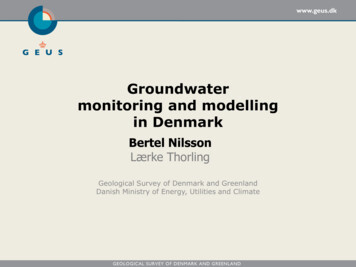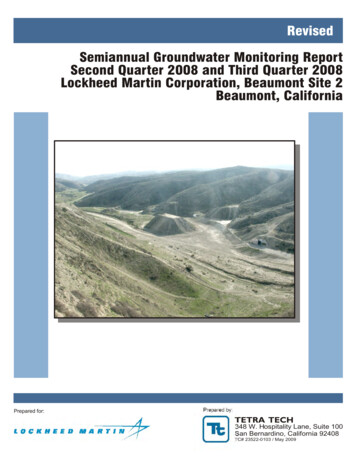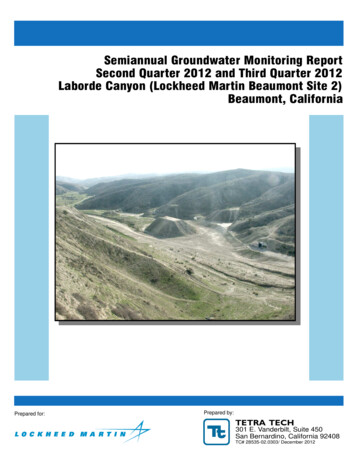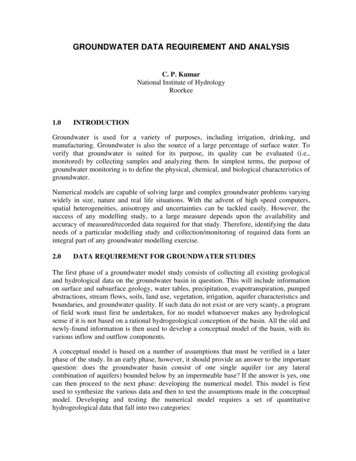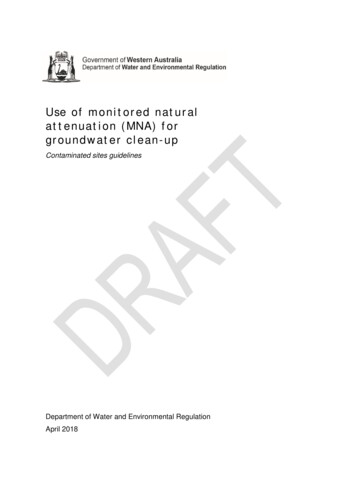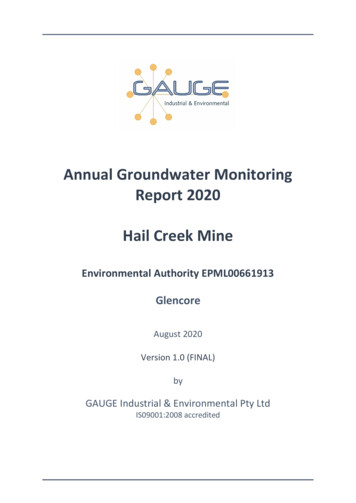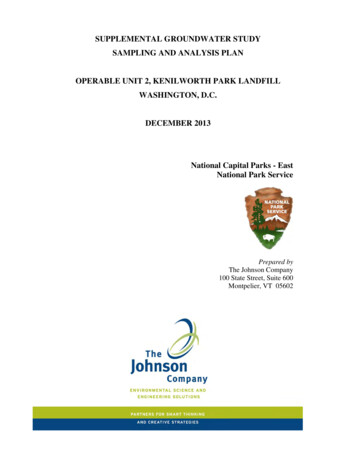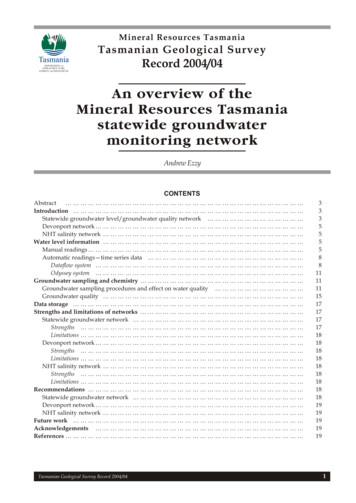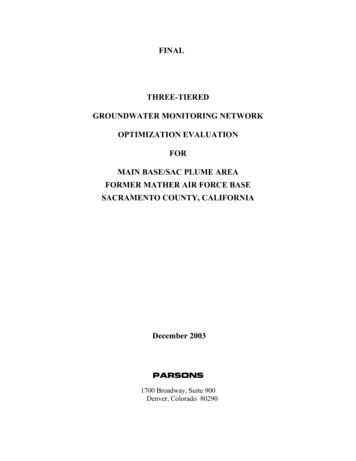
Transcription
FINALTHREE-TIEREDGROUNDWATER MONITORING NETWORKOPTIMIZATION EVALUATIONFORMAIN BASE/SAC PLUME AREAFORMER MATHER AIR FORCE BASESACRAMENTO COUNTY, CALIFORNIADecember 2003Parsons1700 Broadway, Suite 900Denver, Colorado 80290
TABLE OF CONTENTSPageLIST OF ACRONYMS AND ABBREVIATIONS . ivSECTION 1 - INTRODUCTION . 1-1SECTION 2 - SITE BACKGROUND INFORMATION. 2-12.12.22.32.4Site Description. 2-1Geology and Hydrogeology. 2-32.2.1 Geology. 2-32.2.2 Hydrogeology . 2-5Nature and Extent of GROUNDWATER Contamination . 2-7Remedial System . 2-10SECTION 3 – LONG-TERM MONITORING PROGRAM AT THE MAINBASE/SAC PLUME. 3-13.13.2Description of Monitoring Program. 3-1Summary of Analytical Data . 3-11SECTION 4 - QUALITATIVE MNO EVALUATION . 4-14.14.2Methodology for Qualitative Evaluation of Monitoring Network. 4-2Results of Qualitative MNO Evaluation . 4-34.2.1 WT/A Zone Wells. 4-124.2.2 Zone B Wells . 4-144.2.3 Zone D Wells . 4-154.2.4 Laboratory Analytical Program . 4-164.2.5 LTM Program Flexibility. 4-17SECTION 5 - TEMPORAL STATISTICAL EVALUATION . 5-15.15.2Methodology for Temporal Trend Analysis of ContaminantConcentrations . 5-1Temporal Evaluation Results. nal.doc
TABLE OF CONTENTS (Continued)PageSECTION 6 - SPATIAL STATISTICAL EVALUATION. 6-16.16.26.3Geostatistical methods for evaluating Monitoring networks . 6-1Spatial Evaluation of Monitoring Network at the Main Base/SAC AreaPlume . 6-4Spatial Statistical Evaluation Results. 6-186.3.1 Kriging Ranking Results. 6-18SECTION 7 - SUMMARY OF THREE-TIERED MONITORINGNETWORK EVALUATION . 7-1SECTION 8 - REFERENCES . 8-1LIST OF tlePageHydrostraographic Unit Conductivity and Transmissivty Data. 2-7Current Monitoring Well Network . 3-3Main Base/SAC Area Monitoring Well Program Type and MonitoringFrequency Breakdown . 3-11Summary of Occurrence of Groundwater Contaminants of Concern inMonitoring Wells . 3-12Monitoring Network Optimization Decision Logic. 4-3Monitoring Frequency Decision Logic. 4-4Qualitative Evaluation of Groundwater Monitoring Network. 4-5Results of Temporal Trend Analysis of Groundwater Monitoring Results. 5-8Results of Geostatistical Evaluation Ranking of Select WT/A ZoneWells by Relative Value of Total COC Information . 6-6Results of Geostatistical Evaluation Ranking of Select B Zone Wells byRelative Value of Total COC Information. 6-9Results of Geostatistical Evaluation Ranking of Select Zone D Wells byRelative Value of Total COC Information. 6-13Summary of Evaluation of Current Groundwater Monitoring Program. 7-3Summary of Revised and Original Monitoring Programs . FInal.doc
TABLE OF CONTENTS (Continued)LIST OF 46.5TitlePageWT/A Zone Monitoring Well Network and COC Concentrations. 2-9B Zone Monitoring Well Network and COC Concentrations . 3-9D Zone Monitoring Well Network and COC Concentrations . 3-10PCE Concentrations Through Time at Well MAFB-313 . 5-2Conceptual Representations of Temporal Trends and TemporalVariations in Concentrations. 5-3Conceptual Representation of Continued Monitoring at Location Whereno Temporal Trend in Concentrations is present. 5-6Temporal Trend Decision Rationale Flow Chart. 5-7Mann-Kendall Trends for PCE in WT Zone Wells . 5-18Mann-Kendall Trends for PCE in B Zone Wells. 5-19Mann-Kendall Trends for PCE in D Zone Wells. 5-20Idealized Semvariogram Model. 6-3Results of Geostatistical Analysis Showing Relative Value ofInformation of Total COCs in WT/A Zone Wells . 6-5Results of Geostatistical Analysis Showing Relative Value ofInformation of Total COCs in B Zone Wells. 6-8Results of Geostatistical Analysis Showing Relative Value ofInformation of Total COCs in D Zone Wells . 6-12Impact of Missing Wells on Predicted Standard Error . tFInal.doc
LIST OF ACRONYMS AND OCDCADCEESRIETIFFAft/dayft2/dayft/ftGISGWTPIRPIT H-gTPH-dUSAFUSEPAVOCAircraft Control and WarningAir Force BaseAir Force Base Conversion Agencybelow ground surfaceBase Realignment and Closure Actchlorinated aliphatic hydrocarbonCalifornia Department of Water ResourcesComprehensive Environmental Response, Compensation, andLiability Actcarbon tetrachloridecontaminant of concerndichloroethanedichloroetheneEnvironmental Systems Research Institute, Inc.extraction, treatment, and injectionFederal Facility Agreementfeet per daycubic feet per dayfeet per footgeographical information systemgroundwater treatment plantInstallation Restoration ProgramInternational Technology CorporationLaguna-Mehrten transitionlong-term monitoringmicrogram(s) per litermaximum contaminant levelmonitoring network optimizationMontgomery Watson HarzaNational Priorities Listoperable unitperchloroethene, a.k.a. tetrachloroethenepractical quantitation limitremedial action objectiveRecord of DecisionStrategic Air Commandtrichloroethenegasoline-range total petroleum hydrocarbonsdiesel-range total petroleum hydrocarbonsUnited Stated Air ForceUnited States Environmental Protection Agencyvolatile organic DraftFInal.doc
SECTION 1INTRODUCTIONGroundwater monitoring programs have two primary objectives (U.S. EnvironmentalProtection Agency [USEPA], 1994; Gibbons, 1994):1. Evaluate long-term temporal trends in contaminant concentrations at one ormore points within or outside of the remediation zone, as a means ofmonitoring the performance of the remedial measure (temporal objective); and2. Evaluate the extent to which contaminant migration is occurring, particularly ifa potential exposure point for a susceptible receptor exists (spatial objective).The relative success of any remediation system and its components (including themonitoring network) must be judged based on the degree to which it achieves the statedobjectives of the system.Designing an effective groundwater monitoring programinvolves locating monitoring points and developing a site-specific strategy forgroundwater sampling and analysis to obtain enough relevant information to satisfy thedata quality objectives of the monitoring program at the least cost. The effectiveness of amonitoring network in achieving these two primary objectives can be evaluatedquantitatively using statistical techniques. In addition, there may be other importantconsiderations associated with a particular monitoring network that are mostappropriately addressed through a qualitative assessment of the network. The qualitativeevaluation may consider such factors as hydrostratigraphy, locations of potential receptorexposure points with respect to a dissolved contaminant plume, and the direction(s) andrate(s) of contaminant rDraftFInal.doc
This report presents a description and evaluation of the groundwater monitoringprogram associated with the Main Base/Strategic Air Command (SAC) Industrial AreaPlume at the former Mather Air Force Base (Mather) in Sacramento County, California.A 306-well monitoring network was evaluated to identify potential opportunities tostreamline monitoring activities while still maintaining an effective monitoring program.A three-tiered approach, consisting of a qualitative evaluation, an evaluation of temporaltrends in contaminant concentrations, and a statistical spatial analysis, was conducted toassess the degree to which the monitoring network addresses each of the two primaryobjectives of monitoring, and other important considerations such as regulatory concernsand specific site hydrogeologic conditions. The results of the three evaluations werecombined and used to assess the optimal frequency of monitoring and the spatialdistribution of the components of the monitoring network. The results of the analysiswere then used to develop recommendations for optimizing the monitoring program atthe Main Base/SAC Area Plume at aftFInal.doc
SECTION 2SITE BACKGROUND INFORMATIONThe location, operational history, geology, and hydrogeology of the Main Base/SACArea Plume at Mather are briefly described in the following subsections.2.1SITE DESCRIPTIONMather is a closed military installation located in Sacramento County, California,approximately 12 miles east of Sacramento. The installation is located south of USHighway 50 and north of California Highway 16, and covers an area of approximately5,845 acres. Military activities on Mather AFB were terminated, and the Base wasdecommissioned on 30 September 1993, in accordance with the requirements of the BaseRealignment and Closure Act (BRCA).Various types of contaminants were introduced to soil and groundwater in thesubsurface at Mather AFB during the course of routine Base operations that included fuelstorage and delivery, fire-fighting training, equipment maintenance, waste disposal, andother industrial activities conducted throughout the operational history of the Base.Environmental investigation and restoration activities were initiated at Mather AFB in1982, and continue to the present in conjunction with a facility-wide InstallationRestoration Program (IRP). In July 1989, the United States Air Force (USAF), theUSEPA (Region IX), and the State of California signed a Federal Facilitiy Agreement(FFA), in accordance with the requirements of Section (§) 120 of the ComprehensiveEnvironmental Response, Compensation, and Liability Act (CERCLA), to ensure thatenvironmental effects associated with past and current operations are properly evaluated,and that appropriate restoration actions are taken to protect human health, welfare, andthe environment. The FFA defines the roles and responsibilities of the signatory raftFInal.doc
establishes enforceable deadlines for deliverables, and provides a vehicle for resolution ofdisputes. According to the terms of the FFA, the USAF, as the owner of the site, is theprincipal responsible party, and the lead agency responsible for conducting investigationand restoration activities.The results of early investigations confirmed that volatile organic compounds (VOCs)and other organic contaminants were present in environmental media at several of theIRP sites; and as a consequence, Mather AFB was proposed for listing on the SuperfundNational Priorities List (NPL) in July 1989, and was placed on the NPL in November1989. Several IRP sites were identified in the Final Superfund ROD as sources ofcontaminants in soil and groundwater, with the majority of sites located in the MainBase/SAC Area Industrial Area. The Main Base Plume is a widespread plume composedprimarily of chlorinated solvent constituents dissolved in groundwater, which originatesin the Main Base area and extends off-Base to the west. The SAC Industrial Plume alsoconsists primarily of chlorinated solvent constituents dissolved in groundwater,originating near Site 57 and extending off-Base to the west and southwest. Three othergroundwater plumes have been identified in areas south and/or east of the MainBase/SAC area: the Northeast Plume, the Site 7 Plume, and the Aircraft Control andWarning (AC&W) Plume.The Main Base and the SAC plumes are the focus of this Monitoring NetworkOptimization (MNO) evaluation.For the purposes of investigation and restorationactivities, these commingled plumes generally are regarded as a single plume, and arecollectively referred to as the “Main Base/SAC Industrial Area Plume”. Thecontaminants of concern (COCs) in the Main Base/SAC Industrial Area Plume -dichloroethane(1,2-DCA),tetrachloroethene (PCE), trichloroethene (TCE), 1,1-dichloroethene (1,1-DCE), cis-1,2dichloroethene (cis-1,2-DCE), benzene, xylene isomers, total petroleum hydrocarbonsmeasured as gasoline-range and diesel-range constituents (TPH-g and TPH-d,respectively), and tFInal.doc
The Main Base/SAC Industrial Area groundwater plume consists of severalcommingled plumes originating at Sites 18, 23C, and 57 that are present in groundwaterin the upper part of the water-bearing unit, together with other plumes from sites such as37, 39, and 59 that have commingled at greater depths in the saturated zone. The plumeunderlies the Main Base and SAC Industrial Area and extends off Base to the west[International Technology Corporation (IT Corp.), 1993 and 1994a). That part of theplume within the Main Base area is characterized by relatively higher concentrations ofPCE and relatively lower concentrations of TCE and CCl4, while that part of the plumeoriginating within the SAC Industrial Area is characterized by relatively higherconcentrations of TCE and relatively lower concentrations of PCE and cis-1,2-DCE. Theaxis of the Main Base/SAC Industrial Area plume is oriented east northeast to westsouthwest in general alignment with the direction of groundwater movement acrossMather. The monitoring program for the Main Base/SAC Area Plume is fully describedin Section 3.2.22.2.1GEOLOGY AND HYDROGEOLOGYGeologyA sequence of sedimentary rock and unconsolidated sediments that dip and thicken tothe west underlies the eastern flank of the Central Valley in the vicinity of Mather. Thesesediments were eroded and transported as a consequence of the tectonic uplift of theSierra Nevada Range, which borders the eastern edge of the Central Valley.Thesediments were deposited into the subsiding structural trough of the ancestral CentralValley. This sequence is reportedly approximately 1,000 feet thick beneath the centralpart of Mather, and consists of Late Cretaceous to Eocene marine and continentalsedimentary rock overlain by late Tertiary to Quaternary unconsolidated alluvial andfluvial sediments (Harwood and Helley, 1987).The sequence overlies Jurassic-Cretaceous igneous and metamorphic basement rock. The geologic units of interest atMather are (from oldest to youngest): the Mehrten Formation, the Laguna Formation,and the terrace raftFInal.doc
The Mehrten Formation, consisting primarily of andesitic sand and gravel, is thedeepest and oldest unit (ranging from late Miocene to early Pliocene in age) (Shlemon,1967a and 1967b) of interest at Mather. The Mehrten Formation dips westward (at anangle of 1 to 2 degrees), and thickens westward from 200 feet thick east of Mather, to400 to 500 feet thick beneath the axis of the Central Valley (California Department ofWater Resources [CDWR], 1964). Generally, the contact of the Mehrten Formation withthe overlying Laguna Formation is not distinct, so that a “transition zone” between thetwo formations, ranging in thickness from 60 to 100 feet, is recognized in the generalarea of Mather. The sediments of this transition zone (known as the “Laguna-MehrtenTransition Zone”) consist of a mixture of arkosic sands (similar to the Laguna Formation)and andesitic material (Mehrten Formation). Regionally, the Laguna Formation is arelatively fine-grained unit, consisting primarily of interbedded sand, silt, and clay.However, the Laguna Formation also contains channel deposits consisting of gravel ofmetamorphic provenance, with subordinate granitic silt and sand (Shlemon, 1967a).In the vicinity of Mather, the Laguna Formation is informally subdivided into lower,middle, and upper units (IT Corp., 1994b). The lower unit of the Laguna Formationconsists primarily of discontinuous sand and gravel channel-fill deposits, separated byrelatively thick, fine-grained interbeds (silt and clay), and ranges in thickness from 100 to245 feet. Beneath the northwestern part of Mather and farther west, the lower LagunaFormation contains an interval of superimposed channel-fill deposits (IT Corp., 1994a).The middle unit of the Laguna Formation consists of overbank deposits of silt, with somechannel-fill deposits of silty sand, sand, and gravel, and ranges in thickness from 31 to 63feet. In the western part of Mather, the middle unit is subdivided into two gravel strataseparated by a layer of silt (IT Corp., 1994a). The upper unit of the Laguna Formationconsists primarily of silt, with sporadic channel-fill deposits of silty sand and gravel. Theupper unit ranges from 15 to 130 feet in thickness, and locally becomes thinner in thenortheastern part of Mather.Terrace Gravels of Quaternary and Recent age constitute the uppermost geologic unitat Mather. The terraces were formed during northwestward migration of the channel nal.doc
an ancestral American River. The Terrace Gravels are composed primarily of siltygravel, capped with silt and silty sand.2.2.2HydrogeologyThe geologic units in the subsurface at Mather were informally divided intohydrostratigraphic units to provide a framework for describing the local hydrogeology.The Terrace Gravels are above the groundwater table, and consequently are unsaturatedacross Mather. Hydrogeologic unit “A” of the upper Laguna Formation is the uppermostwater-bearing unit at Mather. Unit “A” lies unconformably beneath the Terrace Gravelsand consists primarily of silt, but also contains thin, discontinuous channel-fill deposits ofsilty sand and gravel. Much of unit “A” is above the groundwater table at Mather, andconsequently is unsaturated; however, the lower part of unit “A” is saturated in thewestern part of Mather.Hydrogeologic units “Bu” and “B” of the middle Laguna Formation consist ofoverbank deposits of silt and channel-fill deposits of silty sand, sand, and gravel; therelative proportions of coarse-grained and fine-grained materials in units “Bu” and “B”are variable, depending upon location. In the Main Base area and immediately west ofMather, units “Bu” and “B” consist primarily of sands and gravels. In this area, multiplesuperimposed and juxtaposed channels form thick, vertically uninterrupted sequences ofcoarse-grained material within units “Bu” and “B”. As a consequence of their relativelyhigh permeability, these channel deposits have the highest water production of any unitswithin the Laguna Formation, and provide the primary pathways for the movement ofgroundwater beneath Mather.Hydrogeologic Unit D of the lower Laguna Formation consist primarily of silt andclay; channel-fill deposits of silty sand and sand within Units C and D typically areseparated by relatively thick deposits of silt and clay. Relatively continuous deposits ofsilt and clay, encountered in the hydrostratigraphic interval between the sands and gravelsof Unit B and the sand of Unit D, are identified as Unit C. In areas where Unit C isrelatively thick and continuous, it may function as an aquitard. Hydrogeologic Unit al.doc
extends from the base of unit C to the top of the transition zone between the Laguna andMehrten Formations; Unit D consists primarily of fine-grained overbank deposits (siltand clay), with sporadic coarse-grained channel deposits. In areas where channel depositsare not present within Unit D, Units C and D consist primarily of silt, and are not readilydistinguished. The E Unit comprises the sands and gravels of Laguna-Mehrten transition(LMT) zone. The underlying Mehrten Formation sands are the producing zone for manyof the off-Base water-supply wells. The hydrostratigraphic unit names used at Matherhave evolved from a system with zones A through E to one with A through D and theLaguna-Mehrten Transition (LMT), but that the model still uses a Unit E for the lowerpart of the Laguna Formation.Regionally, groundwater movement generally is to the southwest, from upland areaseast of Mather toward the Sacramento River. Substantial groundwater pumping wasinitiated in the Sacramento region between 1890 and 1910, and has continued to thepresent (CDWR, 1974).Three groundwater cones of depression located northwest,southwest, and south of Mather have been created by the pumping of municipal andagricultural wells across the river basin. The southwest depression strongly influencesthe rate and direction of groundwater movement at Mather (IT Corp., 1996). Since 1890,groundwater pumping has caused the elevation of the groundwater potentiometric surface(water table) to decline by approximately 70 feet in the vicinity of Mather.Groundwater at Mather is encountered at depths ranging from 52 to 150 feet belowground surface (bgs); the local configuration of the groundwater potentiometric surface issuch that the hydraulic gradient is from northeast to southwest beneath Mather, at about0.002 feet per foot (ft/ft).Groundwater is present under water-table (unconfined)conditions in hydrogeologic Units A and Bu, and under semi-confined conditions indeeper hydrogeologic units. The coarser sand and gravel deposits within Units Bu and Bare fairly transmissive, apparently continuous, and abundant throughout the MainBase/SAC Area, and extend beyond Mather to the West. These coarser-grained intervalsfunction as pathways for the preferential movement of groundwater and dissolvedconstituents.Horizontal hydraulic conductivity and transmissivity and raftFInal.doc
conductivity data for Units A, Bu, B, and D were compiled from wells installed atMather, and are presented in Table 2.1.TABLE 2.1HYDROSTRAOGRAPHIC UNIT CONDUCTIVITY AND TRANSMISSIVTYDATAMONITORING NETWORK OPTIMIZATIONMAIN BASE/SAC PLUME AREAFORMER MATHER AFB, )a/Transmissivity(ft2/day)a/A1 – 290average 482 – 222average 582 – 350average 821 – 182average 293 – 3,378average 5708 – 5,500average 1,55024 – 14,000average 2,55070 – 8,000average 1,596BuBDVerticalConductivity(ft/day)7.7 x 10-3 to 0.17average 0.0276.5 x 10-4 to 0.1average 0.0224.5 x 10-5 to 0.26average 4.5 x 10-30.011 to 1.5average 0.12a/ Montgomery Watson Harza [MWH], 2002ab/ IT Corp., 1994bGroundwater recharge to water-bearing zones underlying Mather occurs in uplandareas to the east. Rainfall, streamflow from the American River, and applied irrigation inupland areas to the east percolate directly into permeable strata that crop out at thesurface and are contiguous with similar strata underlying Mather. Rainfall and irrigationwater occurring at Mather also provide recharge to the groundwater system. Potentialadditional sources of local recharge include the Morrison Creek drainage, Mather Lake,and settling ponds associated with nearby quarries (IT Corp., 1997).Changes inoperation to the settling ponds could potentially impact monitoring wells on the southeastside of the site.2.3NATURE AND EXTENT OF GROUNDWATER CONTAMINATIONContaminants have been introduced to soil and groundwater beneath the MainBase/SAC Area as a consequence of historical activities on Mather. Chlorinated VOCsare the primary contaminants in the subsurface, although the fuel hydrocarbons benzeneand xylene isomers also have been detected (IT Corp., ftFInal.doc
Halogenated VOCs represent the only COCs that are systematically detected atMather. TCE, PCE, and CCl4 are the main contaminants in groundwater beneath theMain Base/SAC Industrial Area (MWH, 2002b). Smaller distributions of the other COCssuch as TPH-g, cis-1,2-DCE, and 1,1-DCE also have been detected in groundwatersamples from a few wells. These other COCs do not form large identifiable plumesbecause their occurance is localized. Prior to installation of the groundwater extractionwells at the site (Section 2.4), the highest concentrations of TCE, PCE, and 1,1-DCEwere detected in samples collected from well MAFB-203, located near the oil-waterseparator at Building 7024 (IRP Site 66) and downgradient of a suspected source area(IRP site 57 concrete wash pads) (IT Corp., 1994a). The highest concentration of CCl4was detected at well MAFB-207, located west of Building 7022 (IT Corp., 1994a)(Figure 2.1). The ROD-established plume cleanup levels for groundwater contaminantsare based on the more stringent of the federal and State Maximum Contaminant Levels(MCLs) for drinking water and other values for contaminants for which primary MCLsdon’t exist. The plume cleanup levels for the COCs are 5 micrograms per liter (µg/L) forTCE and PCE and 0.5 µg/L for CCL4 (AFBCA, 1996).Several distinct “hot spots” (defined to be areas within which the concentrations of aparticular contaminant in groundwater exceed the plume cleanup level for that constituentby a factor of 10 or more) are associated with particular source areas. For example, aCCl4 “hot spot” in the vicinity of wells MAFB-207 and MAFB-246 appears to beassociated with the IRP site 57 wash-pad source area west of Building 7022. Thedirections and rates of groundwater movement beneath the Main Base/SAC Area are suchthat contaminants originating at several source areas have commingled as dissolvedcontaminants have migrated advectively, both laterally and vertically, with movinggroundwater.Contaminants have moved in groundwater from source areas to downgradientlocations beyond the western boundary of Mather, and have been detected ingroundwater samples from several water-supply wells beyond Mather (e.g., the JuvenileHall wells [JH-1 and JH-2] owned by Sacramento County). Contaminants also FInal.doc
41:0,18,0MAFB-093:0,0,0MAFB-107:0.31,1.6,0MBS EW-4A:0,14,0MAFB-342:0,18,0MBS 7,0MAFB-340:0.63,180,0.27 MAFB-097:2.4,0,0.8MAFB-151:0,0.32,0MBS ,0 MAFB-088:1.8,0.38,0.43MAFB-207:21,2.5,8.8MBS PZ-03:310,67,4.8MBS EW4ABu:
4.3 Qualitative Evaluation of Groundwater Monitoring Network.4-5 5.1 Results of Temporal Trend Analysis of Groundwater Monitoring Results.5-8 6.1 Results of Geostatistical Evaluation Ranking of Select WT/A Zone . National Priorities List (NPL) in July 1989, and was placed on the NPL in November 1989. Several IRP sites were identified .
